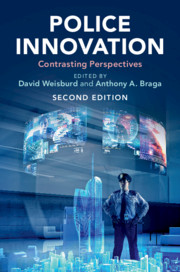Book contents
- Police Innovation
- Police Innovation
- Copyright page
- Contents
- Figures
- Tables
- Notes on Contributors
- Introduction
- Part I Community Policing
- Part II Procedural Justice Policing
- Part III Broken Windows Policing
- Part IV Problem–Oriented Policing
- Part V Pulling Levers (Focused Deterrence) Policing
- 9 Advocate
- 10 Critic
- Part VI Third–Party Policing
- Part VII Hot Spots Policing
- Part VIII Predictive Policing
- Part IX CompStat
- Part X Evidence-Based/ Risk-Focused Policing
- Part XI Technology Policing
- Index
- References
10 - Critic
Partnership, Accountability, and Innovation: Clarifying Boston’s Experience with Focused Deterrence
from Part V - Pulling Levers (Focused Deterrence) Policing
Published online by Cambridge University Press: 09 August 2019
- Police Innovation
- Police Innovation
- Copyright page
- Contents
- Figures
- Tables
- Notes on Contributors
- Introduction
- Part I Community Policing
- Part II Procedural Justice Policing
- Part III Broken Windows Policing
- Part IV Problem–Oriented Policing
- Part V Pulling Levers (Focused Deterrence) Policing
- 9 Advocate
- 10 Critic
- Part VI Third–Party Policing
- Part VII Hot Spots Policing
- Part VIII Predictive Policing
- Part IX CompStat
- Part X Evidence-Based/ Risk-Focused Policing
- Part XI Technology Policing
- Index
- References
Summary
Pioneered in Boston as part of its Operation Ceasefire strategy to halt serious youth violence in the 1990s, focused deterrence approaches (also known as “pulling levers” policing) have been embraced by police departments in the United States and other countries as an effective approach to crime prevention (Travis, 1998; Dalton, 2002; Deuchar, 2013). In its simplest form, the approach consists of selecting a particular crime problem, such as youth homicide; convening an interagency working group of law enforcement practitioners; conducting research to identify key offenders, groups, and behavior patterns; framing a response to offenders and groups of offenders that uses a varied menu of sanctions to stop them from continuing their violent behavior; focusing social services and community resources on targeted offenders and groups to match law enforcement prevention efforts; and directly and repeatedly communicating with offenders to make them understand why they are receiving this special attention (Kennedy, 1997; Kennedy, Chapter 9 in this volume). Although the goal of focused deterrence strategies is to prevent crime by changing offender perceptions of sanction risk, other complementary crime prevention mechanisms seem to support the crime control efficacy of these programs (Braga & Kennedy, 2012; Kennedy, Kleiman & Braga, 2017). These strategies are also intended to change offender behavior by mobilizing community action, enhancing procedural justice, and improving police legitimacy.
- Type
- Chapter
- Information
- Police InnovationContrasting Perspectives, pp. 227 - 248Publisher: Cambridge University PressPrint publication year: 2019
References
- 2
- Cited by



